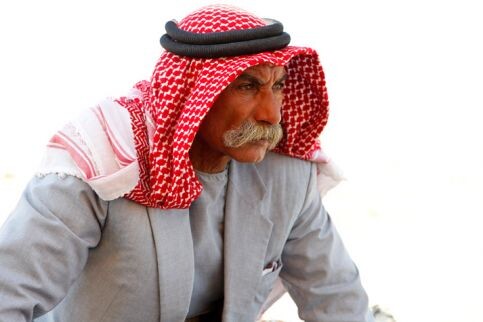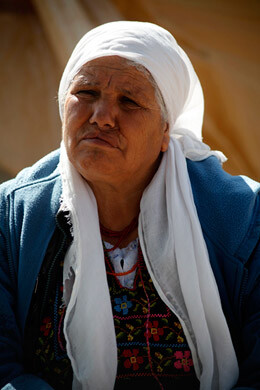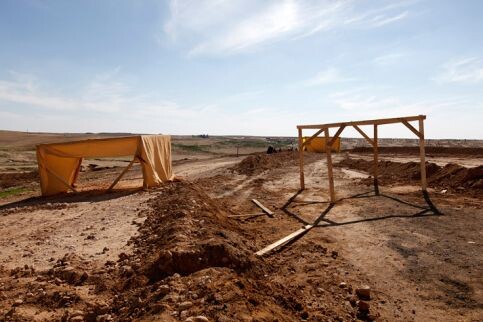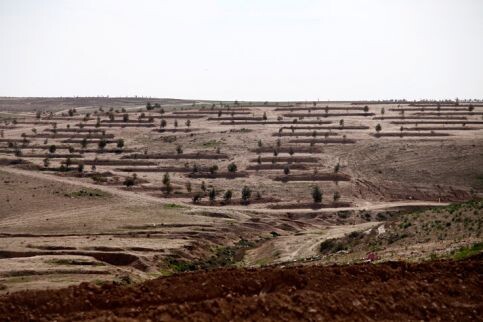The Electronic Intifada al-Araqib 17 March 2011

Sheikh Siyakh al-Turi in al-Araqib village (Elo B)
Reclining under a recently constructed tent in the Bedouin village of al-Araqib, Sheikh Siyakh al-Turi gestured toward the bare terrain surrounding his home. “This is a great example to the world of what Israel is doing to its citizens,” he said. Only a kilometer away from one of Israel’s largest highways, the village is utterly quiet; most villagers have left for their day jobs outside of al-Araqib, leaving only a few to stand watch in the event that the Israel Land Administration returns to demolish the village yet again.
As is widely known, Israel continues to deepen its claims on land in the occupied West Bank — detaching Palestinians from their lands with Israeli-only roads, settlement expansion and the wall. However, the state is aggressively pursuing a similar project within the green line, Israel’s internationally-recognized armistice line with the occupied West Bank.
Many Palestinian citizens of Israel are being displaced not with settlements and a wall, but with the planting of a forest. As it has in the past, Israel asserts that its intentions are beneficent and noble — to make a desert bloom with trees. But these trees will be planted on land inhabited by Palestinians for many generations, and people are being violently forced out of their villages to make room for those trees.
In the Negev (Naqab) region, there are no signs to direct a visitor to al-Araqib; and even after you arrive you may still wonder if you have indeed found the village. Since 27 July 2010, Israel has conducted twenty demolitions of every home and structure in the village, leaving little tangible manifestation of a community that has lived there since the Ottoman Empire.
Not provided with water, plumbing, electricity or any other public services supplied to the rest of Israel’s citizens, villagers of al-Araqib are fully tapped into the revolts around the Arab world that are challenging the stability of tyrannical regimes. Villagers insist that such a revolt will come to the West Bank and Israel soon.
With a transistor radio at his feet, Smayeh, a resident who declined to give his full name and who remembers when Israel first relocated his village in 1953, told me firmly, “Israel is more oppressive than most Arab regimes.”
Pushing Palestinians off the land
In 1951, only a few years after the mass expulsion of Arabs from the land, the head of the Israeli military government (the body that governed the Palestinians who remained in what is now called Israel, until 1966) approached the leaders of al-Araqib and asked them to relocate their community to the north so that the military could use the southern portion of their land for training. He promised the move would be temporary — only six months.

Sabiyah in al-Araqib village (Elo B)
“Even when we weren’t living there, we would still come back to the land and bring our animals; we never left this land,” Smayeh said.
Smayeh described how in the 1990s, villagers from al-Araqib approached the workers and explained to them that this was their land and they were supporting Zionism by working on it.
“Then they left. And we moved back. We built our houses, set up running water and got a generator for electricity.”
Sitting under the only trees left in the decimated village, a small cluster of pepper trees near the cemetery, I spoke to Smayeh and his wife Sabiyah five days after the Israeli army demolished all structures in the village for the 18th time on 17 February. Firing rubber bullets at men and women, young and old, the Israel Land Authority (ILA) and a special police unit had forced the villagers into the cemetery, while they proceeded to destroy their homes and confiscate their water tanks, blankets and chairs. Left with next to nothing, the villagers returned and began to rebuild their homes in what has now become a familiar routine.
With unfathomable resilience, the villagers reconstruct tents after each demolition. Devising simple structures with thin wood planks, the people can barely afford enough plastic tarp to cover the structures and provide shelter. Hakima Rashid, a woman from the village, explains that they let the children sleep in their cars at nighttime because it’s too cold outside in the winter.
Many villagers have chosen to move to the nearby town of Rahat, an urban township Israel established in 1972 for the Bedouins of al-Araqib. Rahat is one of seven “rikazim” — or concentrated towns — the only legal place for Bedouin citizens of Israel to live. Established in the 1960s and ’70s for the displaced Bedouin communities, these urban centers are considered the poorest and most densely populated villages in Israel. The government insists that all other Bedouin communities are illegal — despite evidence that ownership of al-Araqib’s land can be traced back with both British and Ottoman documentation to the al-Turi family.
Talab al-Sana, a Palestinian member of the Israeli Knesset (parliament) who advocates for the rights and recognition of Bedouin villages in the Negev, likens the living conditions of these towns to the cramped refugee camps in the occupied West Bank and Gaza Strip. Approximately 200,000 Bedouins in the Negev are expected to live on 30,000 dunams (a dunam is the equivalent of 1,000 square meters); al-Sana contrasts that with the space to people ratio in Jewish cities. The Ramat municipality of the Negev, for example, provides 4,000 Jewish residents with four million dunams of land.
Yet despite these harsh living conditions, Smayeh said that many members of his community, including his sons and daughters, have all moved there to raise their children.
“Many people had to move to Rahat, especially if they have kids,” he explained. “There is no food, no water here.”
Nevertheless, Smayah and Sabiyah say they will remain on this land. “Why would we leave our land?” Smayah asked.

Recently constructed tents in al-Araqib that villagers have not been able to cover for lack of funds (Elo B)
Village destroyed twenty times
The Israel Land Administration first demolished the village on 27 July 2010. Over the course of the following two weeks — the peak of summer — the ILA returned to al-Araqib three more times. After each demolition, the villagers started from scratch, reassembling homes that had little chance of standing longer than a week. The coming months saw the reconstructed village demolished twenty more times by the ILA.
Since 1960, the ILA has functioned in tandem with the Jewish National Fund , an organization that has been integral in acquiring land in Palestine for Jewish settlement since 1901. The ILA allotted the JNF 50 percent representation in the agency, thus allowing them to have a strong influence in the use of “national” land. While the JNF technically owns approximately 13 percent of the land inside Israel, the ILA controls roughly 93 percent. In 2009, with a slight restructuring of Israel’s land regime, now called the Israel Land Administration, the JNF has retained its grip on how Israel develops its state land (Alaa Mahajneh, “Situating the JNF in Israel’s land laws,” Al-Majdal, Winter-Spring 2010).
Al-Araqib is situated in Israel’s desert, the Negev, which represents approximately 60 percent of Israel. Yet the JNF emphasized with pointed consternation in an interview with this author that only nine percent of the Israeli population resides there. Since 2005, there has been a concentrated effort from a coalition of Zionist organizations — including the Or Movement, a group dedicated to Judaizing the Galilee and Negev, the JNF and the Government of Israel — to relocate and settle Jews in the Negev.
The project is called Blueprint Negev, and as the Director of Tourism, Shaher Hermalin, told The Electronic Intifada in a phone interview, “Everything we do has to do with creating communities — schools; rehabilitative, environmental, educational programs; tourist centers — everything the area needs to bloom and blossom so people around the country will move there.”
His rhetoric, reminiscent of that of the early Zionists, is deceitfully ironic. Since the first demolition of al-Araqib in July 2010, Israel’s army has uprooted 4,500 olive trees and destroyed all of the village’s wheat and barley gardens.
Smayeh noted that for hundreds of years, al-Araqib maintained agricultural lands that propagated wheat, melons and olive trees, among other vegetation. The village also grazed flocks of sheep and goats.
Today, the land of al-Araqib appears naked. Dirt hills with tractor marks running across them are peppered with intermittent tents. There is a small coop with a few goats, some sheep and one large brown horse.

The JNF-planted forest that borders al-Araqib village (Elo B)
Jewish National Fund role
The crucial facet in all of the JNF’s projects is that they enable ethnic exclusivity on the land. The charter of the JNF stipulates that all of its land and activities will be for the sole benefit of Jews. In their own words in a response to a petition filed to the Israeli high court in 2004, “The JNF, as the owner of the JNF land, does not have a duty to practice equality towards all citizens of the state” (“The Jewish National Fund (JNF), Badil, 2007).
The Government of Israel and the JNF have a symbiotic relationship: by transferring state land to the JNF, the government ensures the land will be reserved only for Jews.
Al-Sana asked “What is the difference between the state and JNF? It is a game, the [Israeli government] takes the land and gives it to the JNF, and says it belongs to Jews, not Arabs. Jews from America, Canada, wherever, can own land, but not Arabs. It’s just a game.”
Surrounding the parameters of al-Araqib are nascent trees that the JNF, or as the organization is known inside Israel, Keren Kayemeth Le’Israel (KKL), has planted. Their trailer and office is within eyesight of where another resident of al-Araqib, Sheikh Siyakh al-Turi, and I spoke.
Sheikh Siyakh condemned the Palestinian Authority and its complicity in Israel’s treatment of all Palestinians in exile, in the occupied West Bank and Gaza and in Israel.
“In the end, who sold our cause?” he asked. “The Palestinian leadership, because the leadership just collaborates … We are the ones standing here; having no food or water and the PA is receiving so much money in international aid. We are the ones protecting the land, so they should support us.”
Because the village land has ceased to provide sustenance and an economic livelihood to the village, some family members have found employment in agriculture or labor elsewhere in the Negev. In many cases, they will bring back their small daily earnings ($8-14 a day) to the village, supporting those who stay on the land during the day in case the police and ILA return.
The violence of the most recent demolition was described as escalating from previous ones: the police forces fired rubber bullets and beat women, causing the men to pick up stones in their defense.
Sheikh Siyakh pulled up his sleeve to show me a red wound where a rubber bullet hit him. Yet despite the ILA showing no signs of leaving al-Araqib alone, Sheikh Siyakh remains confident. “We won’t leave,” he said. It’s not a matter of being optimistic or hopeful. We won’t leave.”
Charlotte Silver is a journalist based in the West Bank. She can be reached at charlottesilver A T gmail D O T com.





